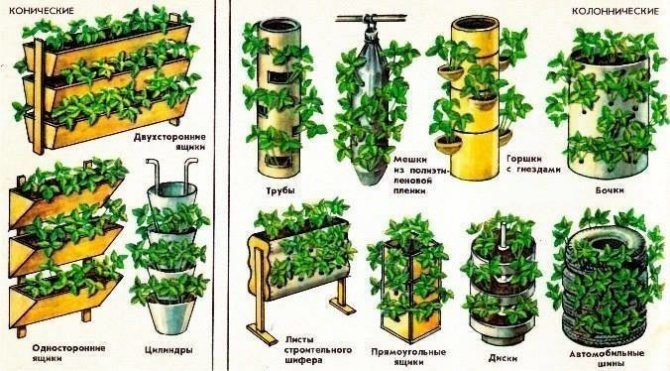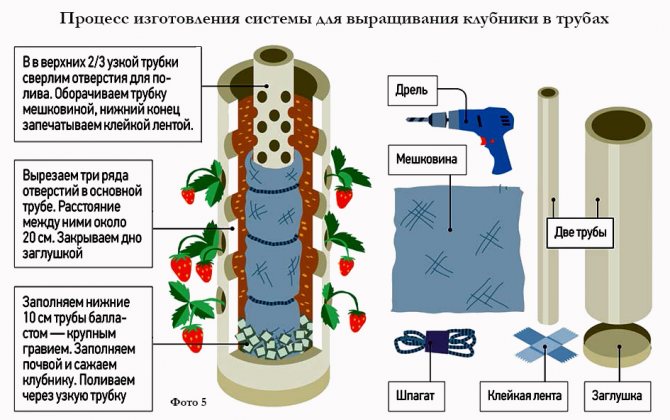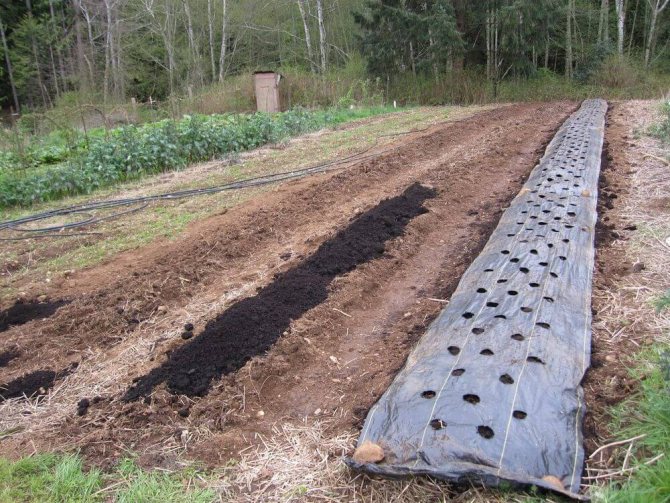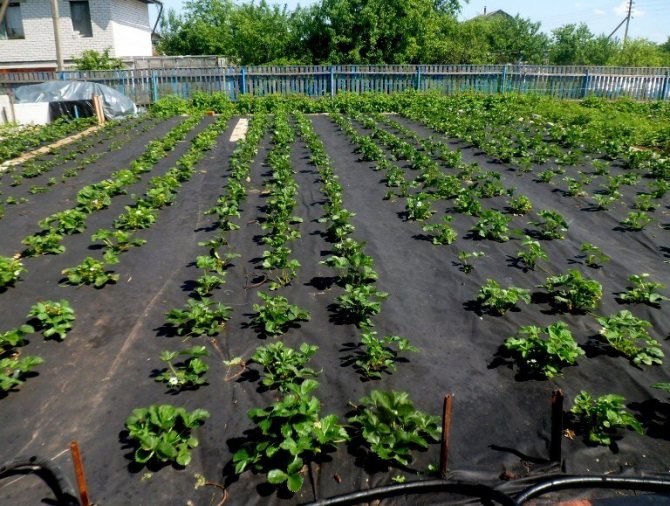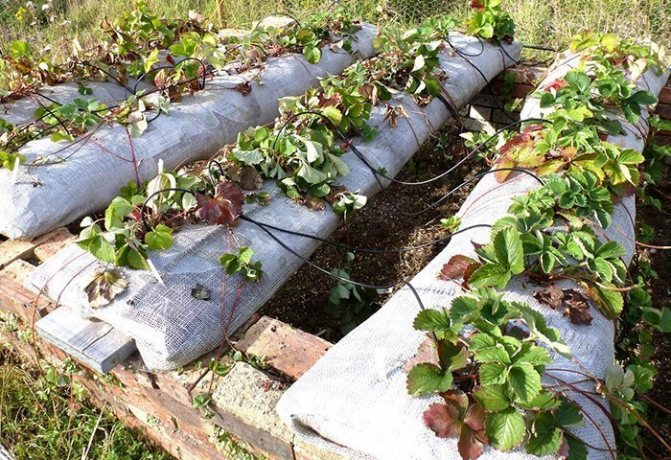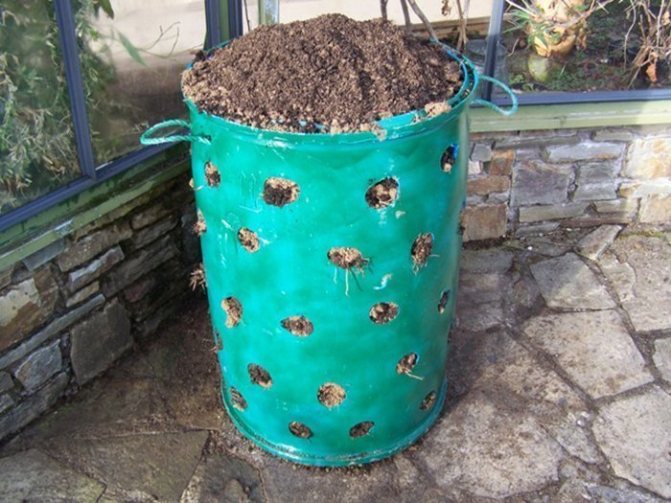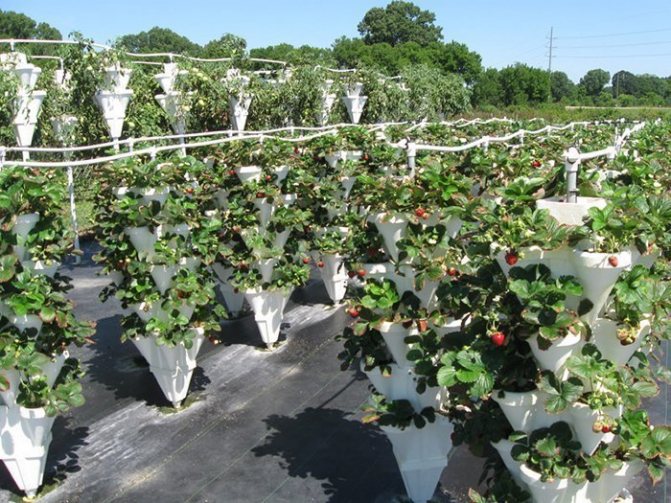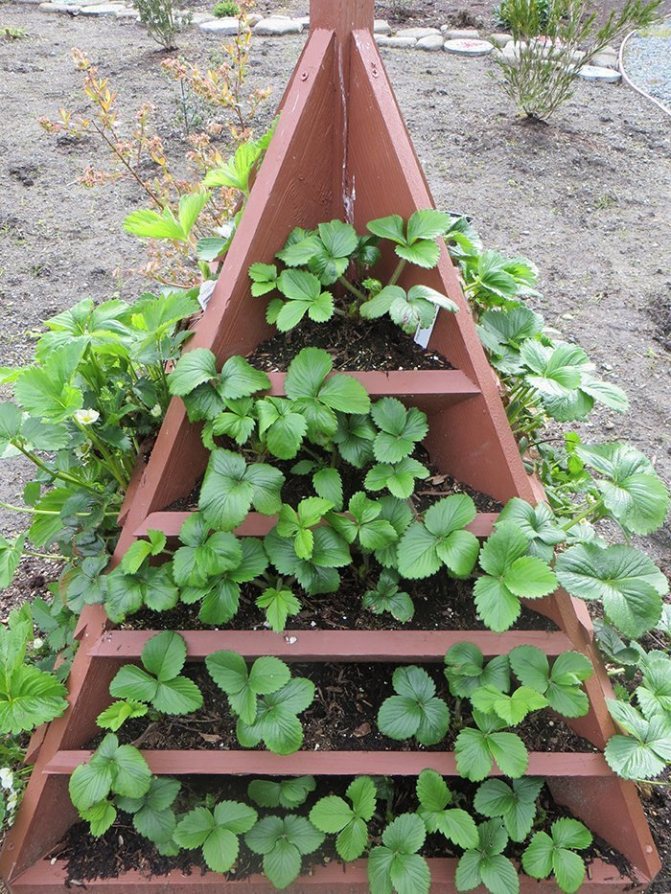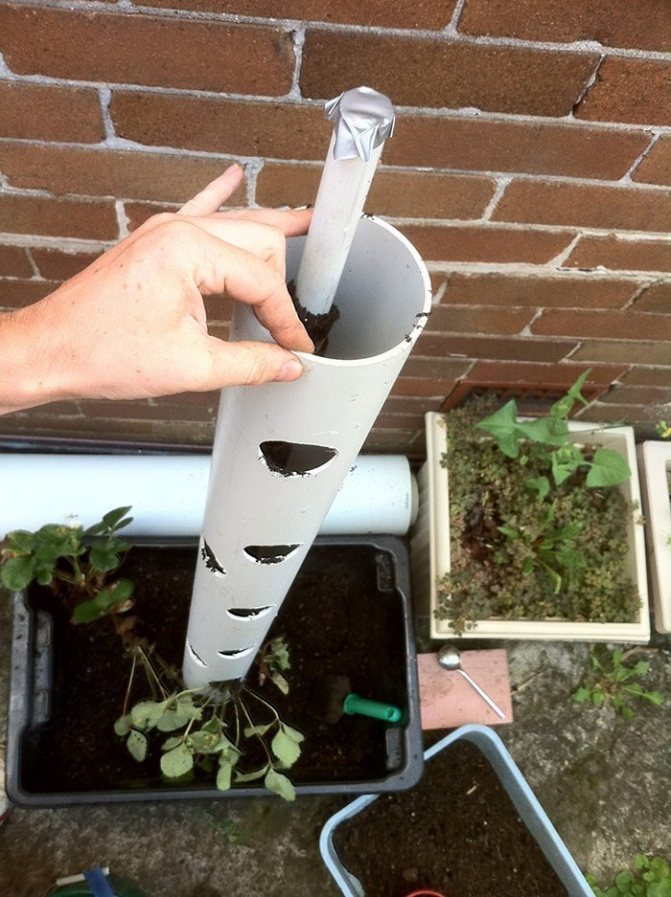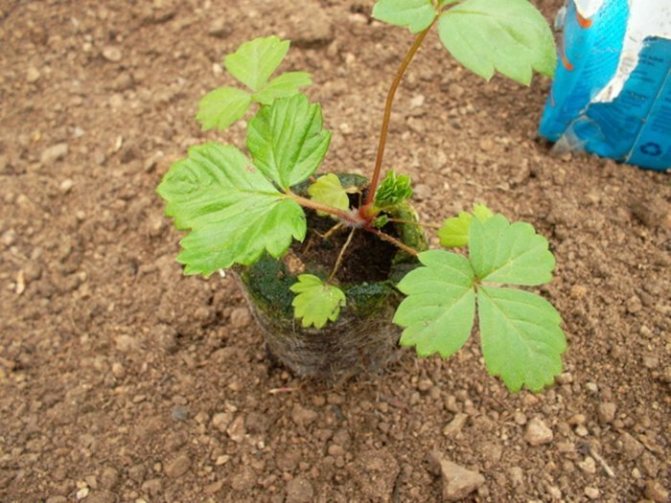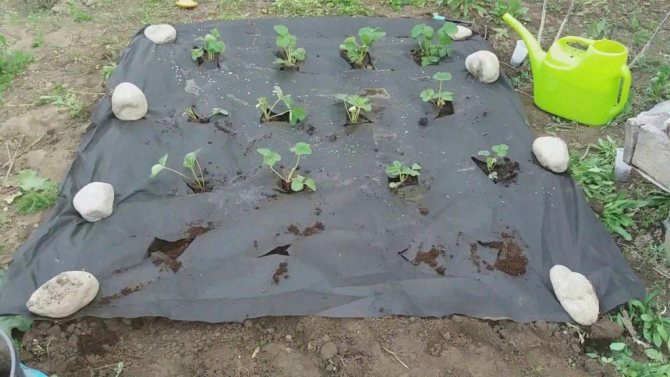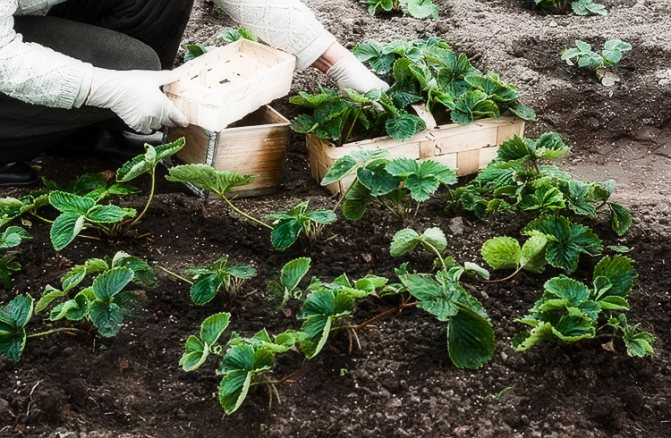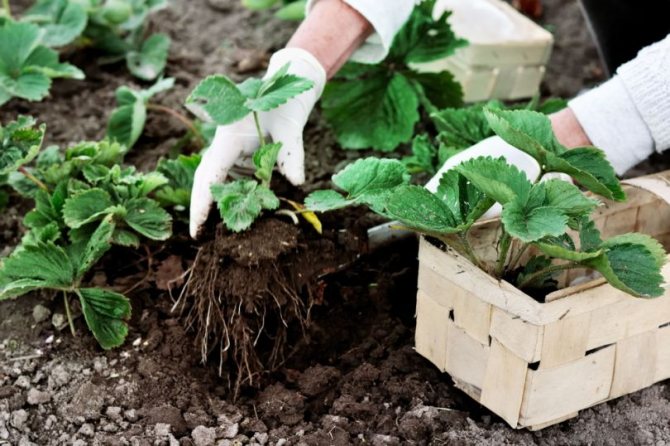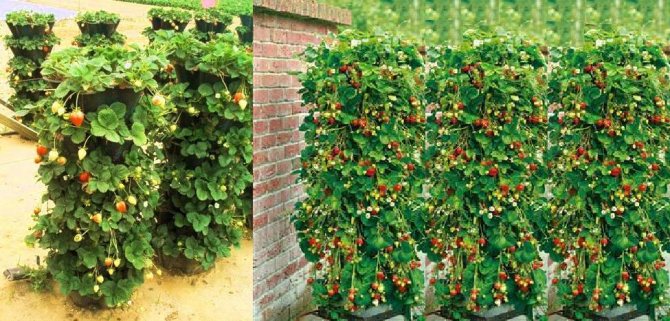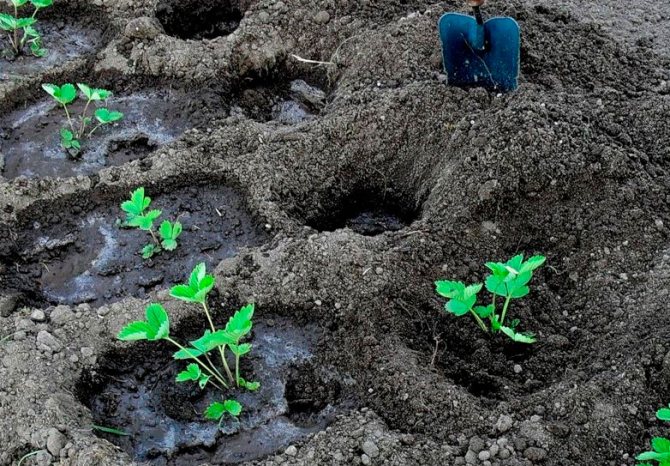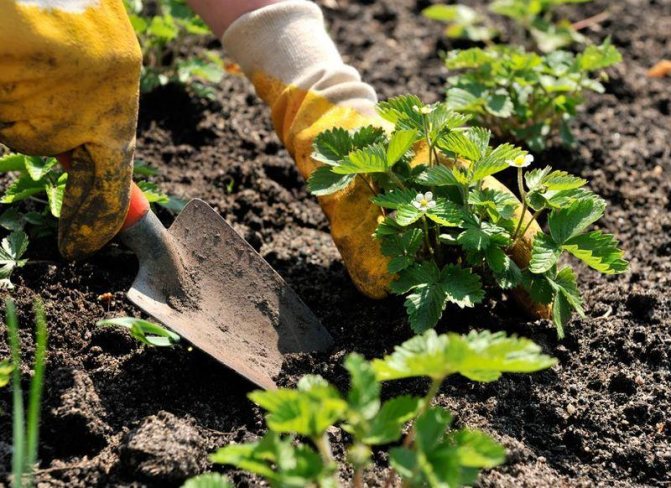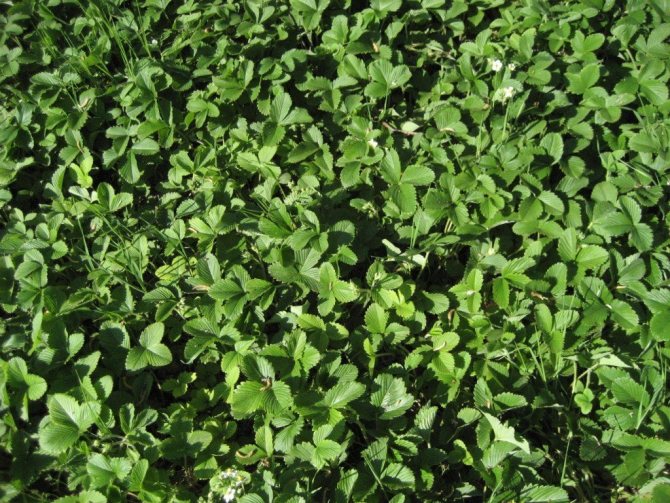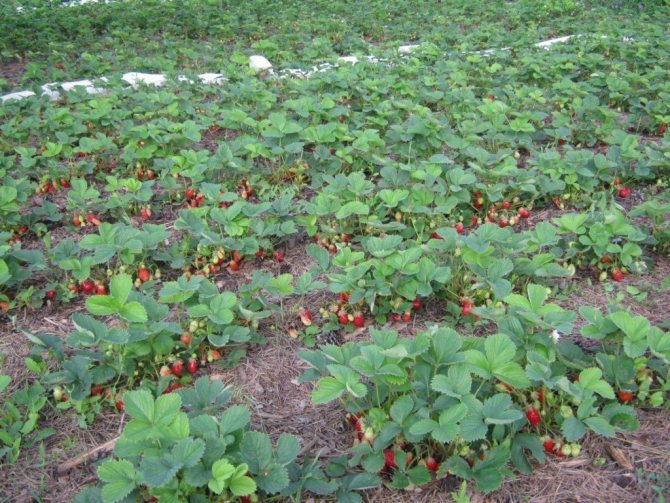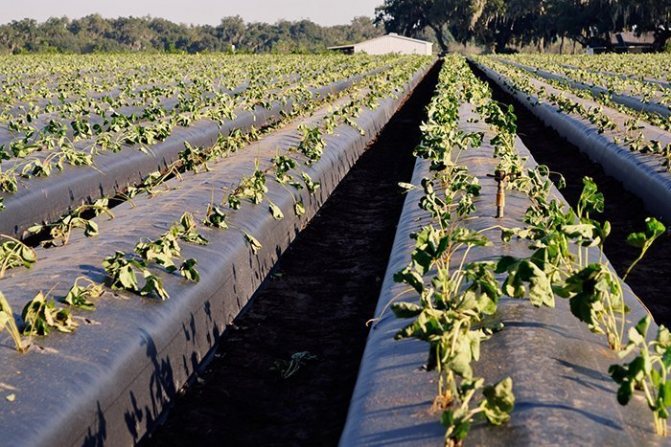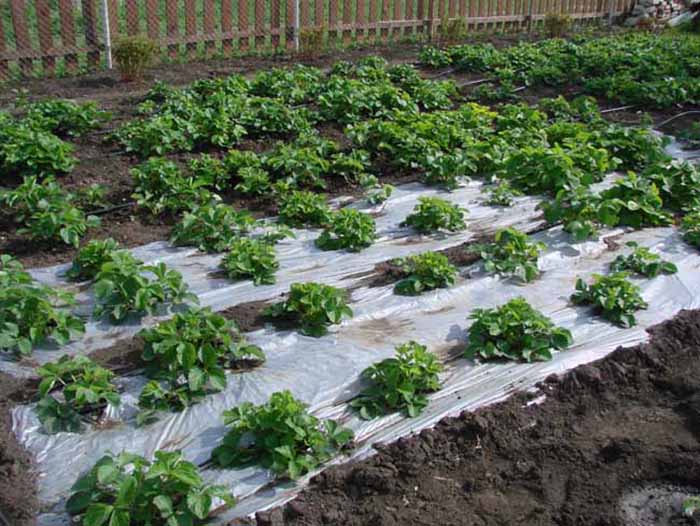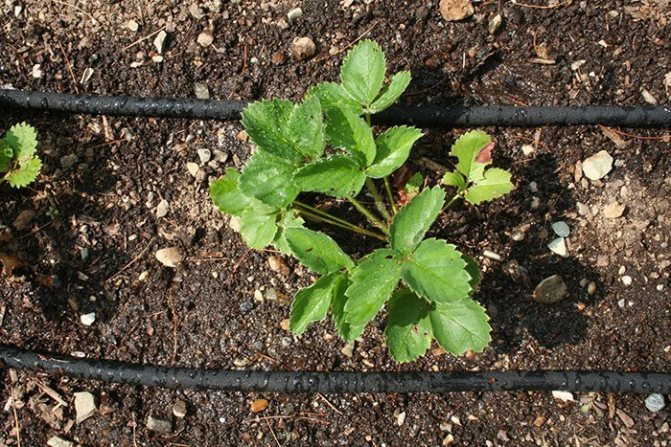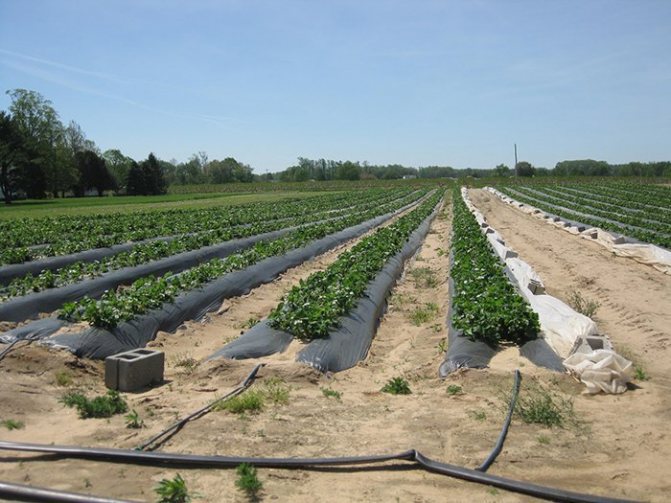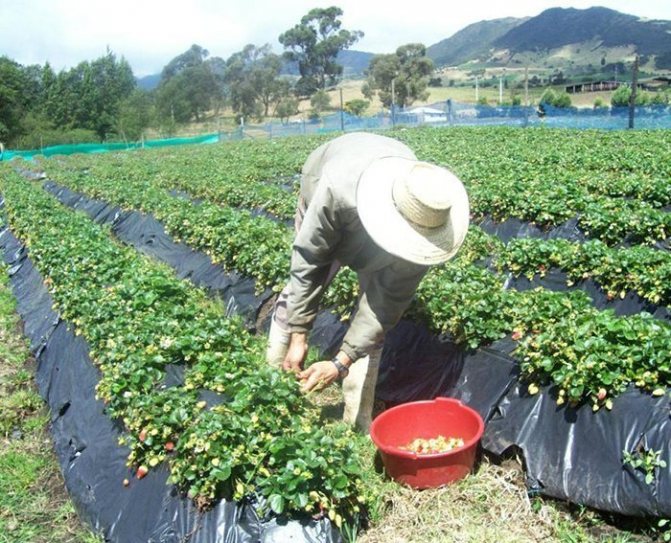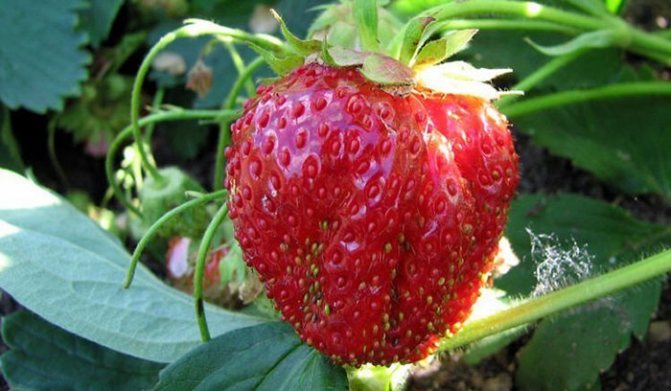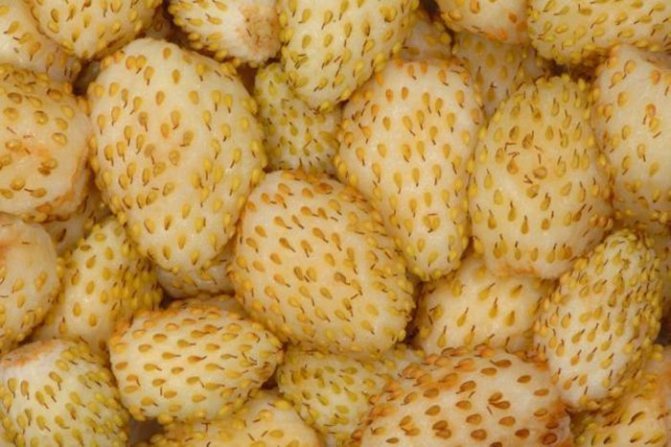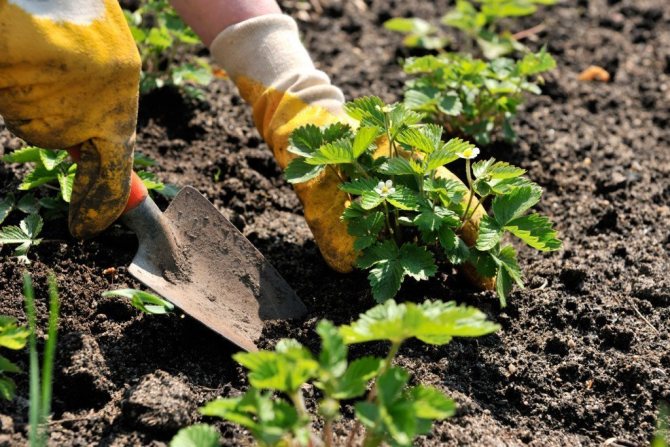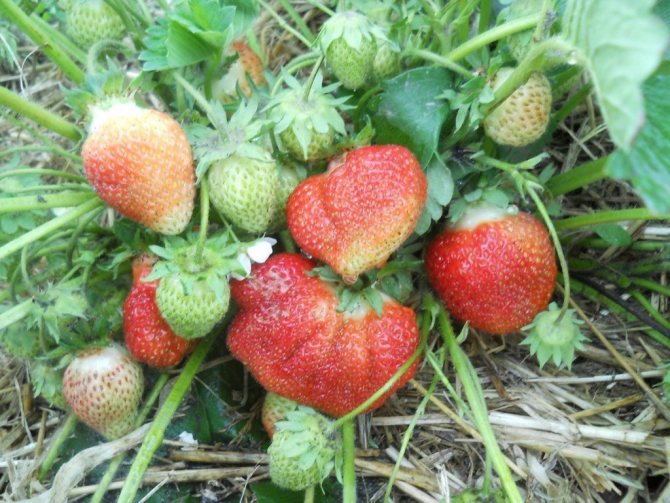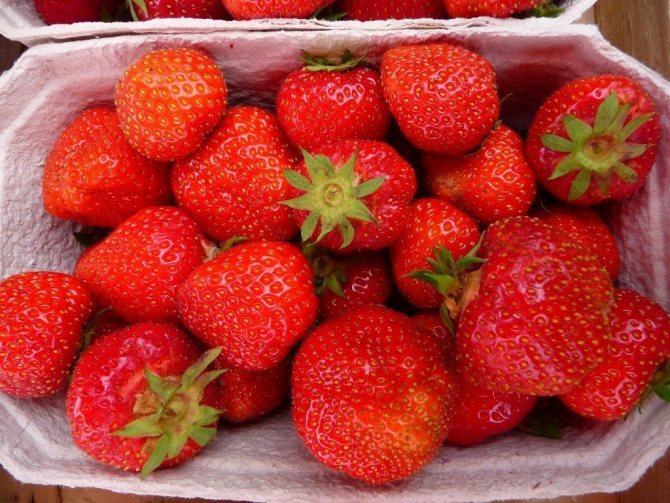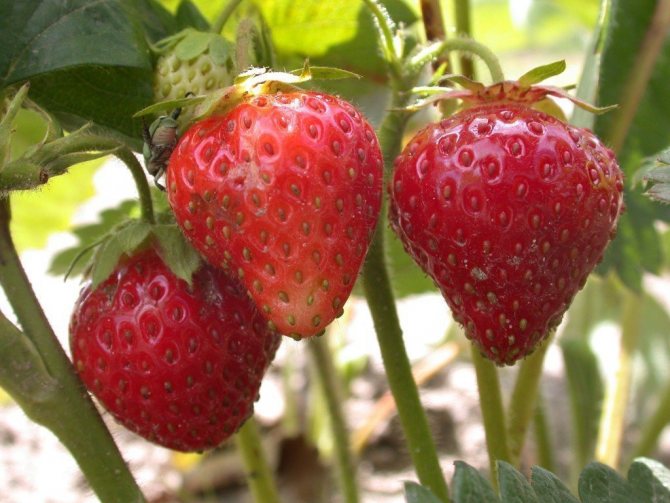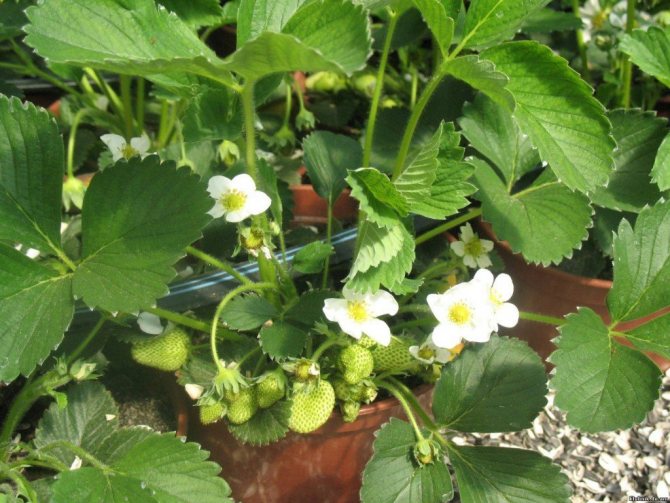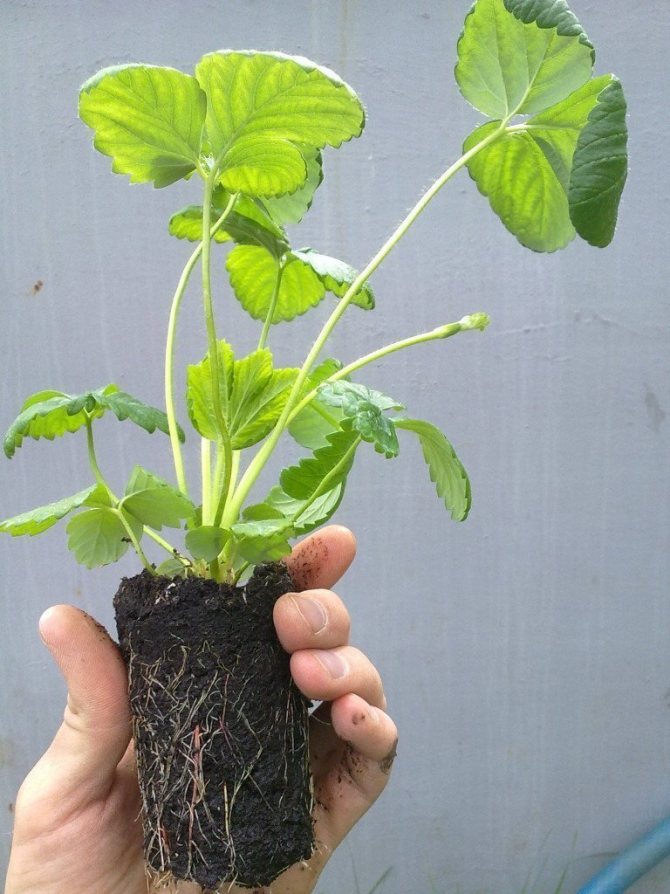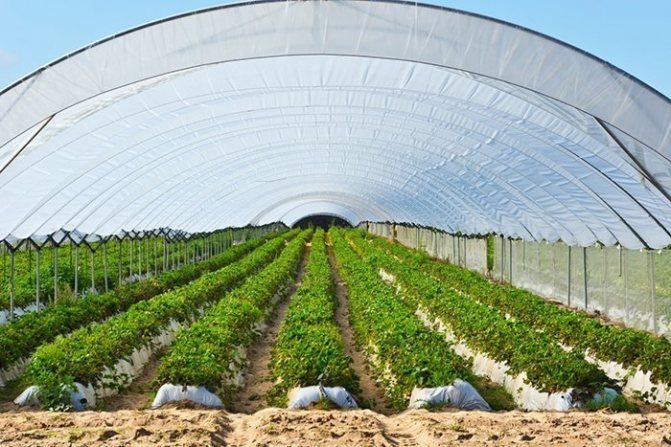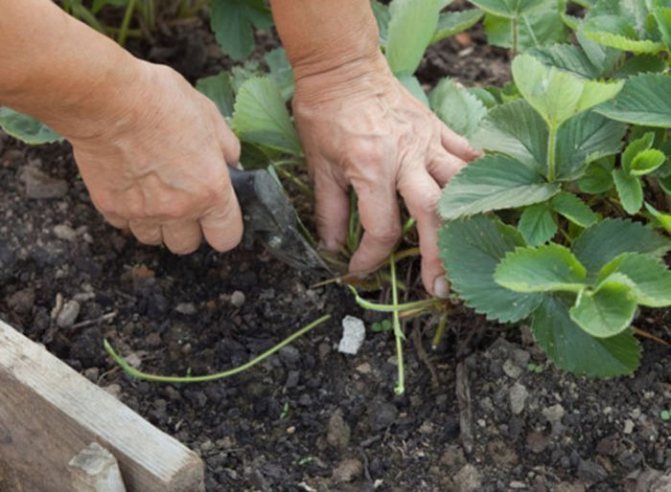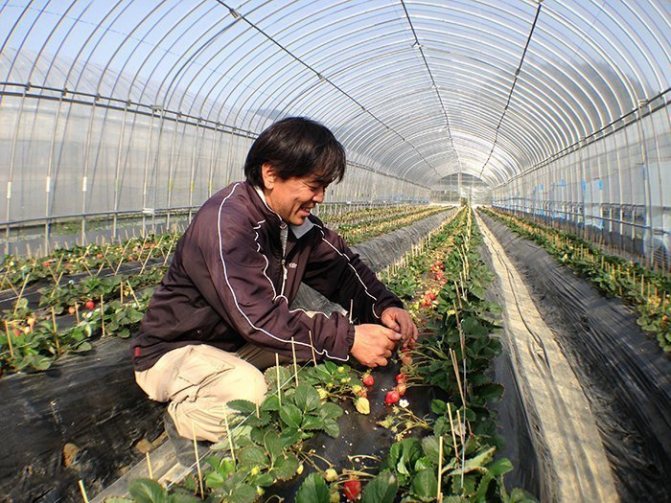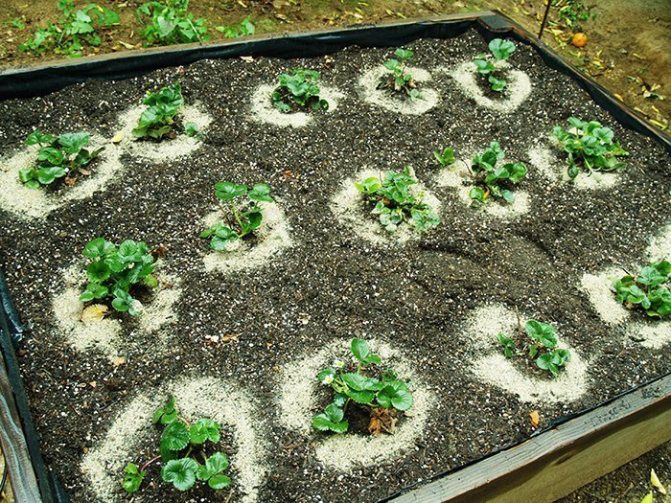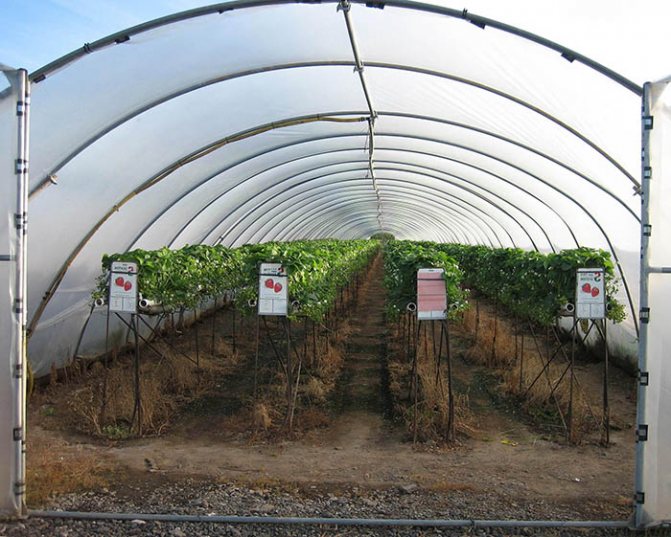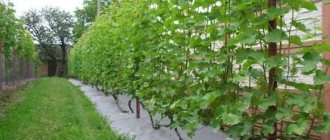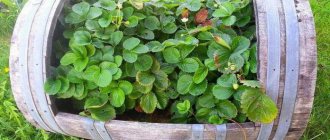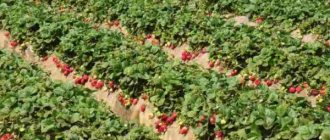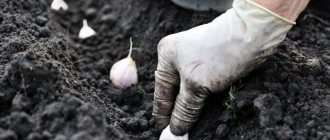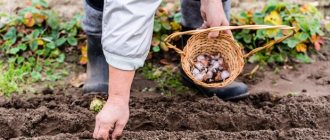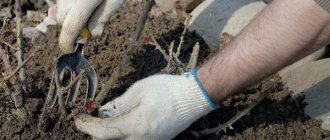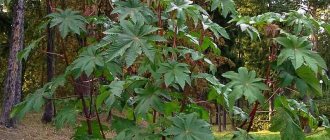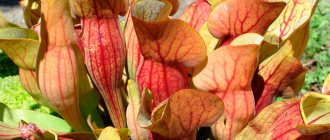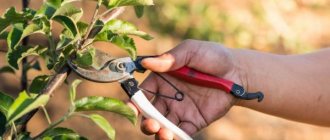Did you know that Dutch technology allows you to grow up to 30 kg of berries per 1 square meter, and plants planted under the film require only 1 watering for the entire season? You will find the most popular ways to grow strawberries and their benefits later in the article!
- Double-row film tunnels
- Unusual strawberry beds
Plastic bags as the most cost-effective planting method
- Dutch technology - expensive but effective
- Vertical solid beds
Choosing a site and soil for growing strawberries
For abundant growth and fruiting, strawberries are best planted in chernozem areas, on dark gray forest soil, on sandy loam and loamy soil, on small slopes on the southwest side. Slower strawberry growth and lower yields are observed when berries are planted on sod-podzolic soil, on clay and light gray soils in the lowlands. The acidity of the land suitable for planting should be at 5-6.5 pH, the groundwater level should be at least 60 cm, and the soil temperature at a depth of 15-20 cm in winter should not fall below -8 ° С.
How to plant strawberries correctly in spring and what predecessors create the most favorable conditions in the soil for its growth? It is great if cereal crops grew on the site before strawberries, the predecessors of the Solanaceae family are less preferable. You should also know that strawberry bushes cannot be planted in the same place where it grew before. You can plant strawberries in the same place only after 2-3 years, so the soil will have time to be enriched with useful elements necessary for full growth, flowering and ripening of berries.
Unusual strawberry beds
Plastic bags as the most cost-effective planting method
Many gardeners have recently switched to bags. This is not without reason, since the advantages of such cultivation are many. Let's take a closer look.
- Minimum costs for pots. Everyone knows that a plastic flower pot is expensive, especially when you count the number of shrubs you want to grow. It's not even worth talking about ceramics or metal - the costs there are simply colossal and the payback will obviously not be earlier than in a year. A plastic bag costs about 10 rubles, and a used one costs 5 rubles, and you can put not 1-3 sockets in it, but about 10-15 pieces.
- Ease of use. All you need is to fill a bag with useful black soil, add organic fertilizers and the job is done - you can start placing the outlets.
- The ability to create vertical beds by tying bags to the ceiling or walls, which significantly saves space, labor costs for picking berries and caring for them.
There are practically no drawbacks, since in one whole you save space, weed control, retained moisture and increased cultivation comfort. The only thing that some gardeners do not like is the untidy appearance of the site, since the bags are not as aesthetic as pots, for example, or M-shaped ridges.
Dutch technology - expensive but effective
Almost in all European countries, where it is much more profitable and more profitable to grow strawberries than in Russia, more modern methods of cultivation are used. Dutch technology has become the most familiar to everyone and 80% of all agronomists in Europe prefer it. It's pretty simple. Ceramic or plastic flower pots with a diameter of up to 45 centimeters are taken and installed on a frame previously welded for them. They are placed in 10-12 rows, thus, the yield from one square meter increases 10-12 times, depending on the density of the placement of pots at one level.
The most suitable method for those who do not have enough area to grow strawberries and need to grow them in a cramped environment. The only disadvantage of this method is the high cost of consumables and labor costs for the construction of the frame. It's too early to talk about profit for the first year, so the cost of a "workplace" will cost you about 2.3-2.6 full harvest of berries. That is, even when growing productive remontant varieties, profit can be seen in the second year and not earlier.
There are, of course, more advantages. Good ventilation of plants, optimal density, extremely comfortable bed and much more. This is an ideal option for everyone who wants to seriously engage in strawberry cultivation in their area, is focused on long-term work with retail outlets, shops. The first 2 years you work for the harvest, and all subsequent years you reap the fruits of your activity, calculate the profit.
Vertical solid beds
This is one of the little-known, uncommon methods of cultivating land on the territory of Russia. Such structures require a lot of labor to be erected and are triangular welded metal plates, inside which there are niches under the ground - it is in them that the sockets are placed.
Labor costs are high, but the convenience of cultivation and space savings will more than compensate for this damage. You can make this kind of bed not only from metal. Plastic, wood, OSB boards, and other materials are perfect for this. The platforms are placed at an angle of 70%, and their height reaches up to 160 centimeters (with manual processing without a step-ladder) or up to 250-300 centimeters, if collection and maintenance of bushes are provided using scaffolds and ladders.
Main advantages: space saving, high planting density, high density of bushes per square meter, ease of maintenance. The disadvantages include immediately the duration of manufacturing places for planting strawberries, as well as the initial cost of the finished structure. The payback is about a year and a half, which is relatively long for this kind of business.
How to properly plant strawberries in spring and autumn
Strawberry bushes are preferably planted in early spring or early autumn. Autumn planting is carried out from August 10 to September 25. Before planting, be sure to properly moisten the ground. Prolonged and later planting of the plant will lead to a significant decrease in the yield of berry bushes. There is an opinion that strawberries can be planted in summer, from July to August, using the two-line planting method. However, this is more an exception than a rule, because in the southern part of Russia and Ukraine during the summer-autumn period there is little rainfall, and the temperature of the soil and air rises so much that no measures of humidification and shading will give the desired result. In this case, there is a great risk of wilting and death of plants.
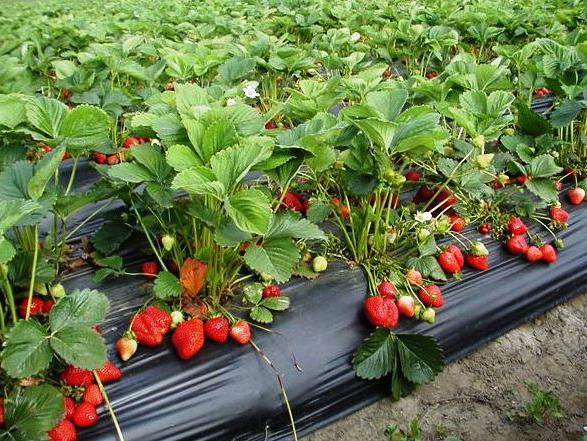
Storing strawberry seedlings in winter
There are several technologies for storing seedlings, but the most common is to store planting material in boxes, the bottom of which is lined with slightly damp moss. From above, the seedlings are covered with lids with small ventilation holes. The room where the seedlings are stored should not only be ventilated, but also keep the temperature around 2–6 ° C warm.
Air requirements at the place where the seedlings are stored.
| Demand | Indicator |
| Air humidity | 90% |
| Carbon dioxide content | 5% |
| Oxygen content | 2,5% |
There are other technologies for storing seedlings, but they are not widely used among experienced gardeners. Long-term storage technology is also useful if the weather or lack of prepared soil does not allow planting strawberries at the end of summer. Then the grown mustache or seedlings must be saved until spring.
Some gardeners prefer to treat plants with fungal agents just before placing them in the chamber.
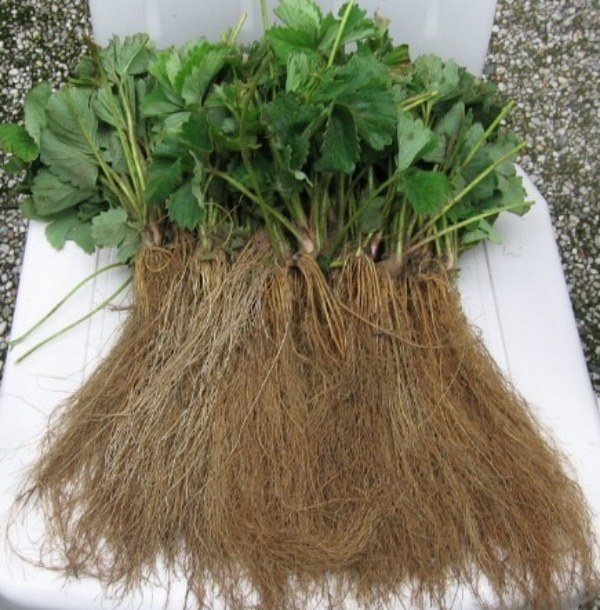

When preparing plants for storage for a long time, the soil is carefully removed, the roots are straightened and the plants are collected in bunches.
Any cooling method is able to maintain the vital parameters of strawberry seedlings for up to one year.
Storage of seedlings in the apartment just before planting
If the planting material was purchased, but it is not possible to plant it right away, then you need to sprinkle the roots of the seedlings with earth and water or spray them regularly. The main thing is not to let the root system of the plants dry out. With this care, the seedlings will be able to hold out for 2-3 days.
Steps to take before planting strawberries
A few days before planting, the seedlings must be placed in a cool place. To prevent drying out and ensure an easier survival of the plant, immediately before planting, its roots are dipped in a clay chatterbox. It is necessary to plant seedlings in moistened soil; it is important to protect the container with young seedlings from direct sunlight during work. The root system of the planted bush should be 7-10 cm in length, if it is larger, then it can be cut to the required size. If after planting there is a possibility of cold weather, then the seedlings need to be covered with foil.
How to plant strawberries in spring? Some features must be observed:
- Weed strawberries carefully enough, as various weeds can interfere with their growth and flowering.
- Before planting, it is advisable to disinfect the soil with appropriate compounds.
- The beds on which plants of the Solanaceae family were previously grown are not suitable for the growth of strawberries.
- Strawberry whiskers should be planted in moist soil, after keeping them in a container with water.
- On peat and sandy soil, plant rosettes are best rooted.
- When planning to plant strawberries in early spring, prepare the soil at the end of summer.
The rules for how to plant strawberries, the photos below show clearly.
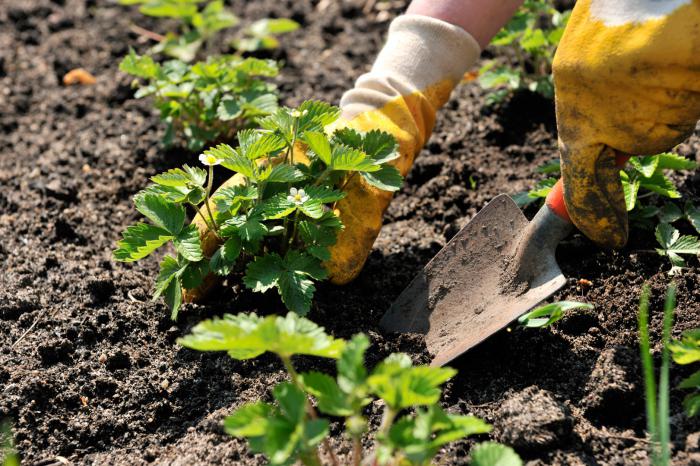

Strawberries in the country - care and weed control
Strawberry care is quite difficult. More precisely, it is laborious, since you will have to perform certain actions almost every week to improve the conditions for the growth and development of the bushes. First of all, special attention is paid to weeds. They can be dealt with in several ways:
- Weeding and pulling out weeds is the most common method and involves manual labor. Suitable for small areas of strawberries. It is necessary to ensure that the strawberries are as pure as possible, and nothing interferes with their development. Even in the absence of weeds, it is necessary to carry out periodic weeding - it kills the "threads" (the remnants of the root system of weeds and young seedlings that are contained in the upper ball of the soil and suck out useful substances).
- Agrofibre or black film. This is a relatively new technology, which involves covering the entire area with a film or special black fiber, through which light does not pass. Weeds do not grow, but a hole is made in place of the bushes through which the bush is pulled out. Thus, only strawberries have access to light. The advantages of this method:
- berries are not in the ground, they are always clean;
- more moisture accumulates, strawberries should be watered less often;
- weeds do not need to be removed - they do not grow under the film.
- Pesticide. This method implies treatment with continuous herbicides, such as Hurricane or Roundup before planting strawberries, but we will not consider it, since any pesticides have a bad effect on human health.
Watering also plays an important role. If you cannot make a drip, you need to ensure watering using sprayers. Keep the top layer of the earth constantly moist. Watering is best at night or in the evening, about 1 time for 3-4 days.
Strawberries love the sun, but with an excess of it, the leaves can "burn". They turn orange. If possible, then you need to cover the area with "shade" - a special grid that reduces the amount of transmitted light on the site.
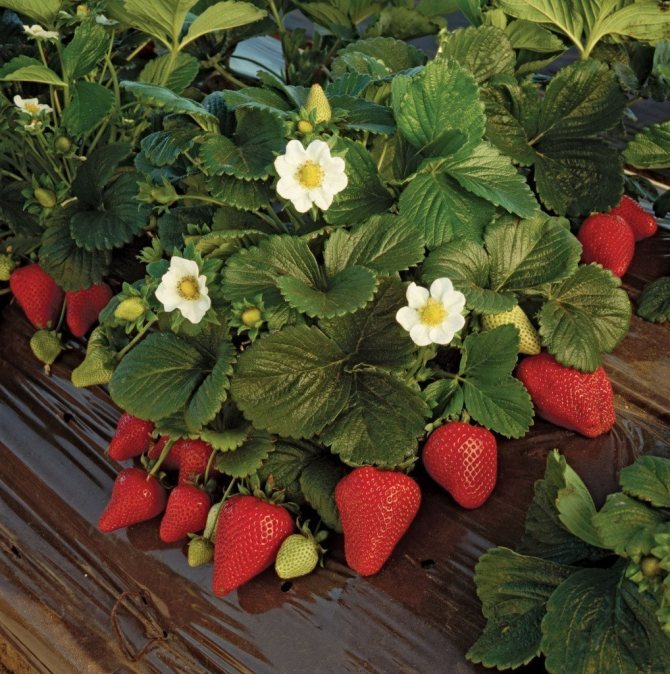

Watering correctly
The quantity and quality of strawberries depends largely on the amount of moisture supplied. So, in hot weather and a long dry period, the plant should be watered 1-2 times a day. Watering should be done in moderation, in small doses, otherwise a large amount of water will lead to rotting berries, the appearance of diseases and pests.
- Before flowering, seedlings must be moistened with sprinkler irrigation.
- During the flowering period, the plant is watered at the root, while moisture should, if possible, exclude the ingress of moisture on the leaves, flowers and berries.
- The optimum water temperature for irrigation is + 16 ° C.
- During the rainy period, the beds should be covered with plastic wrap.
Mulch and cover plantations
These planting methods need to be placed in a separate group, since they represent a completely different type of cultivation, care. Today, they practice covering strawberries with a film, filling them with mulch (needles, sawdust) or growing berries on spandex (agrofibre). There are enough advantages: moisture remains for several months under mulch or film, there are no weeds at all, the berries are always clean, they will not get dirty in the ground or substrate.
Unfortunately, there are also disadvantages. The tendrils of strawberries cannot take root, so they are not suitable for those who are engaged in its cultivation. The roots of the plant do not breathe, so specific fungal diseases can develop, it is not recommended to keep the berries under the covering material for a long time. But, in any case, such methods are most suitable for summer residents who grow berries for themselves, do not count on long-term commercial activity.
There are really many ways to grow strawberries, and the choice will depend not only on your financial capabilities, but also on the free time that you can spend on processing the site. Choose the method that suits you and get big harvests of berries until the very frost!
Films for growing strawberries
With an early spring planting of a plant, the question is very relevant: how to plant strawberries under a film? Such a shelter provides plants with easier development and earlier maturation. This method is very effective when growing early strawberries. Film tunnels are the most easily constructed shelters. To do this, you need to install wire arcs at a distance of 1 m from each other. The structure should be about half a meter high. Fasten the film over the arcs so that it does not sag, use jute twine. For the convenience of carrying out earthwork in the film tunnel, one side of it must be well fixed, and the rail must be attached on the other side. Collect the film on the end of the greenhouse and tie it into a knot, attach it to the pegs, which you then dig into the ground.
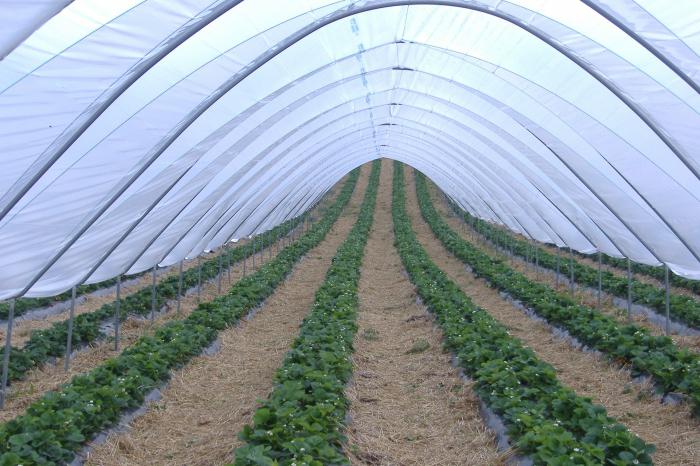

Trapezoidal ridges and their benefits
This method of planting strawberries is the most traditional for many gardeners.For several decades it has been used for industrial cultivation in the fields, since labor and financial costs are minimal. In addition to the availability of the method, it has a large number of advantages, which we will now consider.
- Good air exchange. The trapezoidal ridge allows not only to facilitate harvesting, but also to provide the roots with as much air as possible, which is vital for them to develop properly. Planting simply in the ground or under the film does not give the desired result, and the trapezoid is the ideal shape.
- Ease of creation. It can be done manually in your country house or with the help of mechanized means. In Europe, special trailed equipment is used for tractors, which pulls out two parallel holes, and the top of the "edge" is smoothed out. Thus, in just a few minutes, the field turns into a high-quality planting area. Even some varieties of black currant and grapes are often planted on the ridges, since it is convenient, profitable, quickly.
- Low labor costs. People can walk along the slopes of the trapezoid or technological paths, while with their hands they can reach the middle of the ridge from either side. Planting sockets is very convenient, it takes little time, since they can be placed anywhere in the ridge in a few seconds.
- Quick picking of strawberries, grooming. All berries are available to the worker, they hang directly on the sides of the trapezoid. This allows you to quickly identify all ripe fruits and collect them.
There are few drawbacks to the trapezoidal landing, but they are present. The first is a large number of weeds that need to be removed periodically. Good conditions are created not only for the cultivated plant, but also for all weeds, which, especially when watering, grow much faster than outlets.
Another significant disadvantage is the need for drip irrigation (you can also water it with sprayers), since increased air exchange causes moisture to evaporate from the soil. Labor costs are large, but they are easily justified when harvesting.
Care for strawberries in a film shelter
To control the temperature, a thermometer should be placed inside. If the indicators rise above + 25 ° C, then the greenhouse must be immediately opened and ventilated. In good sunny weather, during flowering bushes, the film can be removed for 1 day. At the time of harvest, the film is completely removed.
In the summer, the berry is watered once a week, certainly in the early morning before the onset of heat, and certainly with warm water. Periodically, you need to weed the beds, monitor the health of plants, and exterminate pests in time.
In the autumn season, strawberries should be covered with fallen leaves, spruce branches, straw. If there is no such material for shelter on the site, then the bushes can be piled up without sprinkling the growth points. At the same time, it is necessary to apply fertilizers from a mixture of peat and compost.
Top dressing
Strawberries are fed four times, with a complex fertilizer that contains nitrogen, phosphorus, potassium with trace elements. The first top dressing is applied in early spring, as soon as the strawberries begin to grow, then as flower stalks appear. Third dressing before flowering. And the last fourth in mid-August. Just at this time, the formation of the future harvest takes place and strawberries need potassium. For a high yield, it is necessary to carry out foliar dressing with microfertilizers at least twice. This should be done at the beginning of flowering and during the growth of the ovaries. Mullein or bird droppings are also used for feeding. Poultry droppings and mullein are diluted with water 1: 10. You can add urea and ash (1 matchbox of urea 0.5 cups of ash per 10 liters of water) under each bush for a liter.
How to grow strawberries from seeds?
Growing strawberries with seeds can give good results, but only with selected plant varieties. Hybrid varieties are definitely not suitable for this.
To do this, you need a container 10 cm deep, it should be filled 5 cm with special soil for seedlings and thoroughly watered. Spread the seeds evenly apart and cover with clear glass, without the need to sprinkle soil over the seeds. The box with soil and seeds should be placed in a warm place, when the first shoots appear, move it to the most illuminated place and remove the glass. After the first leaves appear, you need to pick into separate pots and add special fertilizers for strawberries every two weeks. When the seedlings grow to their optimal size, they can be planted in an open country house. Be careful when choosing where to plant your strawberries. When landing, you need to adhere to some more rules:
- You need to plant the plant shallow.
- The apical kidney cannot be covered.
- Strawberries that are planted too shallow can expose their roots and get sick.
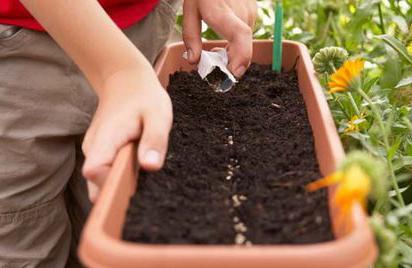

Double-row film tunnels
This method is for those who want to diversify their leisure time, spend enough time with strawberries. A very effective, cost-effective method that will bring a large harvest, but there will be a lot of worries in the greenhouse. First of all, you will need to pay a lot of attention to the formation of rows, since their height should be at least 45 centimeters, so that the air exchange in greenhouse conditions is exactly the same as in open ground. That is, you will have to throw large "barricades" with a shovel, inside which to make another small ditch for irrigation (only after the ground has stood and rammed).
Next, you need to take care of planting bushes. The M-shaped ridge has 2 heights, at the peak of which bushes rosettes should be placed. A drip irrigation hose will pass inside such a letter "M", therefore, the sockets must not be allowed to "slide out". Abundant moisture will not be useful for them, the roots will rot, and mottling forms on the leaves.
The advantage of this planting method is a high density per square meter, as well as a high yield due to abundant irrigation, planting density. Ideal for greenhouse maintenance, but not suitable for outdoor use. Some gardeners pour potash, ammonia fertilizers directly into the location of drip irrigation - the roots of plants do not come into contact with concentrated substances, but gradually absorb (absorb) them.
There are some secrets to growing strawberries on a "double" bed. You can not plant varieties that form many antennae - annual care will be very difficult and lengthy, since the increased density will create a large number of problems when removing whiskers, increasing yields. It is necessary to abundantly fertilize the site with organic substances in order to achieve high weight and good taste from the fruits. Without organic matter, periodic top dressing, it makes no sense to count on a yield of more than 300-400 grams from one bush, even if you are growing remontant strawberry varieties.
Strawberry seeds: how to collect them?
For the successful cultivation of strawberries from seeds, only the largest berries should be used, which are harvested between July and August. The thin surface layer of the berry must be carefully removed, you can use a blade to grind it on the fabric. Dry the resulting material in the sun, disassemble the seeds and transfer to a paper bag. Store them at room temperature before planting.
For growing strawberry seedlings from seeds, it is preferable to choose the following varieties: "Sakhalin", "gourmet", "bogota", "mutofavorite" and others. In order to enjoy the berries longer, you can grow early and later strawberry seedlings together.
Features of planting in a greenhouse
Self-pollinating remontant varieties are chosen for growing strawberries in greenhouses. Ideally suited for this, the favorite of all summer residents - Elizabeth 2.
The soil must be thoroughly disinfected, treated with fungicides, since at high humidity, strawberries suffer from fungal diseases. Recommended humidity is 70-80%. With early planting, provide illumination for 12-14 hours.
The location of the beds is chosen based on the capabilities of the greenhouse, many prefer vertical cultivation. Seedlings are transplanted into greenhouses when it is possible to maintain a temperature of 20-22 °. Do not forget to open the greenhouse for ventilation.
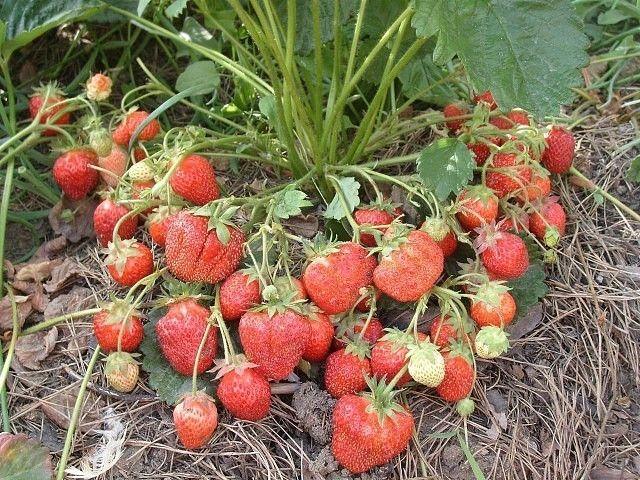

What to plant next to strawberries?
To create the most favorable conditions for strawberries to grow, you can plant some healthy crops next to them, such as parsley, spinach, or bush beans. To scare away slugs, planting parsley in the aisle of strawberries is very effective. The berry can also coexist with beets, radishes, radishes, onions, lettuce, cabbage, or garlic. Sage and borage are equally good for strawberries. Covering the soil with pine and spruce needles will have a very beneficial effect on the taste of the fruit.
What should be done with berries before winter and how to protect bushes from freezing at -30 0С?
Preparing a plant for the winter is quite simple and does not require any special knowledge and effort. The main thing is that the plant does not become icy and freeze, otherwise there is a high probability of its death. If the winter is snowy and the snow falls before the ground cools down to -10 ° C, then there will be no problems at all, and the strawberries can easily wait out long frosts of 30-40 degrees under a white carpet. But you should not rely on weather conditions, and it is better to protect your crop from freezing. This can be done in the following ways:
- Falling asleep with needles of strawberries. The most effective method, which involves throwing a layer of needles 6-7 centimeters on top of the strawberry leaves, which are bent to the ground for the winter. Such a shelter will reliably protect the plant from any frost, and under the snow the strawberries will be even warmer.
- Wood sawdust. At any woodworking plant, you can take a lot of sawdust for a penny and cover the entire area of strawberries with them. They not only protect it from the cold, but also become an excellent fertilizer, after the wood rotted in the spring rains. In the spring, the "coverlet" can be removed from the bushes with a rake and left in the aisles.
- Sprinkle with earth. The method is very laborious, since in the spring you will have to pull each bush out of the ground, clean, level the ground.
If you do everything right and follow the instructions, you will not only get tasty and large berries in a couple of months, but also multiply the bushes and get 4-5 times more plants next year! Growing tasty and healthy berries at home is not only easy, but also pleasant, as they are natural and healthy!
Growing strawberries in a line way
The strawberry planting scheme is quite simple. Wet and cloudy weather will be ideal for disembarkation. The methods of distributing seedlings on the soil can be different: two-line, two-line on the beds or one-line. The most optimal fit is a two-line fit. At what distance to plant strawberries is the most frequent question for novice gardeners. It should be distributed at a distance of 15-20 cm, while the distance between the rows should be from 60 to 70 cm, between the lines themselves - 30 cm.With the one-line method, the same proportions are observed, with the only difference that there is only one line. The beds need to be located from north to south.
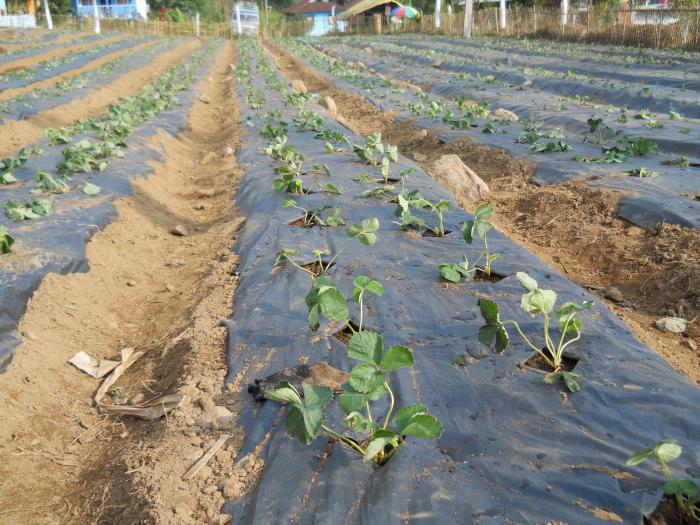

Recently, experienced gardeners and gardeners, in order to protect their plants, have increasingly begun to use lutrasil or roofing material materials. In the process of work, holes are made in the material at a distance of 25-30 cm from each other and strawberry bushes are planted.The hole can be made with a bayonet shovel, and the seedlings should not be located too deep in the soil and not too shallow, otherwise they will not take root.
Consider
Some rules before planting strawberries.
Before planting, strawberries must be disinfected in a solution of copper sulfate (100 grams per 10 liters of water) for five minutes, then rinsed in water.
Remove diseased plants.
If the plot with strawberries is large, then the whole must be treated for diseases and pests. Even with no signs of disease.
Plant onions and garlic, calendula flowers and marigolds next to strawberries. Their scent will scare away all pests.
Do I need to remove the mustache?
The first year, large mustaches take root between the bushes of a healthy rosette. This contributes to the fruiting of the beds for 2 - 3 years. In the future, the mustache must be removed.
Major mistakes
- Many people subject strawberry seeds to additional treatments with growth stimulants or other treatments. This is not allowed, since they are often sold already processed, which ultimately causes drug overdose and subsequent death.
- Using cardboard containers for juices or milk for growing seedlings is one of the most common mistakes. Practice shows that seedlings grow much better in plastic containers or pots.
- Strong burial of seeds during planting, which can lead to the fact that the seedlings will not sprout at all. The seeds are only slightly pressed into the ground, deepening or sprinkling with earth on top is an unnecessary and unnecessary measure.
- Lack of disinfection of the soil used for seedlings. Any earth must first undergo heat treatment, for this it will be enough to warm it up in the oven, which will destroy all parasites and pathogens of various diseases.
Variety selection
Any strawberry can be grown vertically. But ampelous, that is, cascading or curly varieties, are best suited for this purpose. In addition, you should opt for a mustache-forming remontant strawberry. It will bear fruit until autumn. In this case, the fruits are formed not only on the mother bush, but also on the antennae.
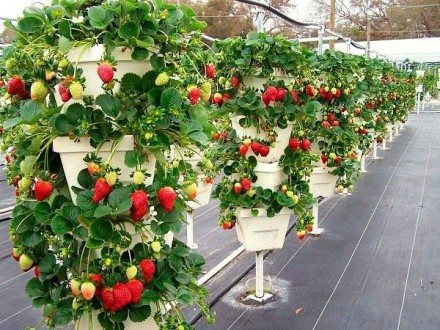

Let's take a closer look at the most popular varieties.
- Alba is a productive early variety. The berries are bright red in color and have a very dense and juicy flesh. The main advantage of the variety is resistance to low temperatures.
- A homemade delicacy, an early remontant strawberry used in ornamental gardening. On long peduncles, sweet and sour berries of medium size, painted in a rich red color, ripen.
- Ostara is a variety bred by Dutch breeders specifically for ampel cultivation. It has a compact bush with dark green leaves and small, but very juicy sweet and sour berries. Does not stop bearing fruit even with the onset of autumn.
- Geneva is one of the most undemanding varieties to care for. The bush has long paniculate peduncles, on which large fruits with dense pulp grow.
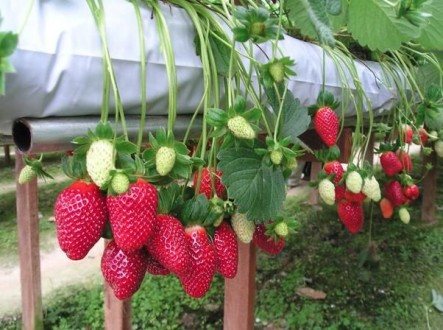

- Alyuba is one of the largest-fruited remontant varieties that are suitable for vertical planting. The berries are very firm and sweet and can be transported well.
Growing berries in plastic bags
Abundant flowering, fruiting, excellent plant growth is achieved in containers made of dense polyethylene. A bag of any size is filled with a substrate enriched with potassium fertilizers, microelements, moderately moistened. Young strong seedlings sit in the cruciform holes. It is worth bringing drip irrigation, artificial lighting.
Such a bed is easy to move, but it is better to assign it a stationary place in a closed, bright room with a stable room temperature in order to enjoy the yummy all year round.
If desired, the bag, tied with a twine, can be easily placed vertically in order to save space, hung, put in two tiers.
An inconvenient side is the requirements for a special reinforced shelter if wintering is to be done in the garden and the difficulty of ventilating the root system in the hot season. The filler is quickly depleted and needs to be replaced.
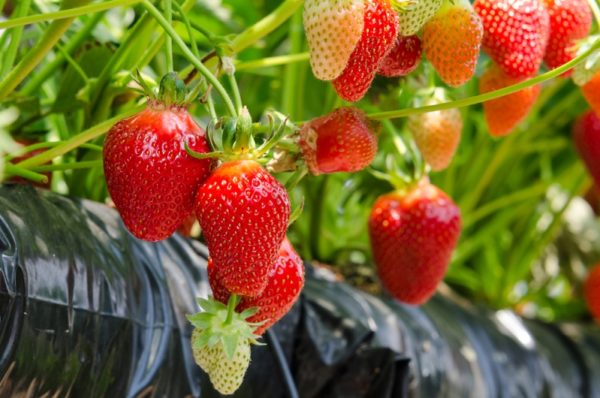

Strawberries in plastic bags
Carpet method
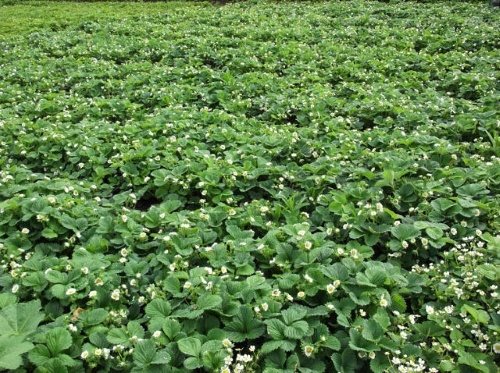

One of the easiest ways to grow summer berries. All that is needed for this is to prepare the site and plant it with seedlings. Humus is introduced for digging. In autumn, strawberries are planted in uterine rows. About 20 cm should be left between the bushes, and about 70 cm between the rows. The uterine rows in the next couple of years rapidly grow antennae and self-propagate. It turns out such a green carpet, the boundaries of the rows are lost.
The advantages of the carpet method are minimal maintenance. No need to remove the mustache, watering and weeding often. Strawberry carpet holds moisture well and drives out most weeds.
Of the shortcomings, it is worth noting that it becomes difficult to harvest in a couple of years due to the density of the cover. In addition, the berries become smaller.
Spring sanitation
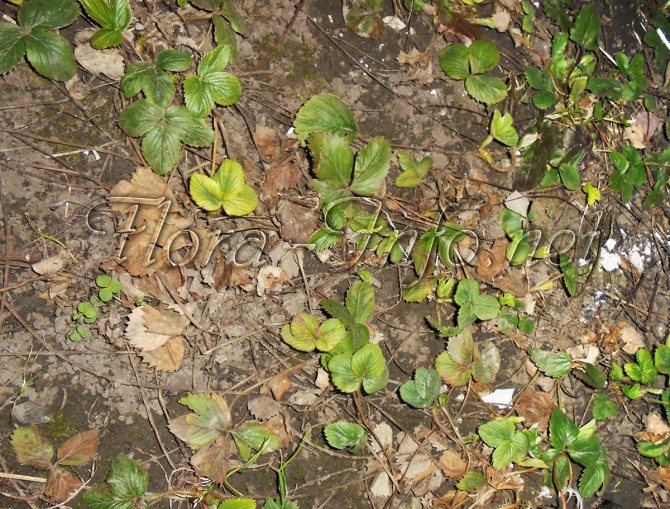

The photo shows that the young foliage has already begun to grow, and the old one, the mustache and debris have not yet been removed. This should not be allowed.
With the onset of the first warm days, the soil begins to warm up rapidly. Strawberries start growing quickly, the rosette grows rapidly. We need to hurry. Cleaning the aisles, foliage and mustache is a necessary agrotechnical measure.
If the aisles have not been dug up since the fall, this can be done in the spring, but it is better that the wintering forms of pathogens and pests do not have time to come to the surface. If digging is not planned, then it is necessary to loosen the soil caked after snow.
Inspect the plantation regularly. Take action when you see the first signs of pests or diseases. Timeliness will not allow the pathogen to spread and the pest will multiply.
Gardening tips
- High quality sandy loam that is suitable for growing strawberries can be obtained from ordinary turf soil. The necessary layers are cut down in forests and clearings, after which they undergo a refinement procedure. This option is well suited for summer residents, in areas of which there is no soil suitable for growing strawberries.
- It is necessary to ensure that old foliage does not remain on the beds., and also the thickening of the seedlings during planting was not allowed, since this can lead to the defeat of strawberries by various diseases, including gray rot.
- The main parasite that infects strawberry seedlings is the strawberry mite. If this parasite has been noticed or has already been removed from the seedlings, then all the foliage must still be removed, which will help to avoid recurrence of its appearance.
The advantage of Dutch technology
The main secret of the Dutch technological process is obtaining a large crop outside the open field. In this case, the beds are containers of various sizes and shapes:
- Boxes;
- Containers;
- Pots;
- Bags;
- Nonwoven sleeves.
The first condition for creating an ideal microclimate is a high sterility of the soil and selected planting rosettes. It is imperative to observe the neutrality of soil pH and control its chemical composition. Regularly do laboratory fences, tests. The second requirement is sufficient lighting for at least 12 hours a day and uniform alternation of day and night.
The cultivars must be self-pollinating, otherwise the flowers will not turn into an ovary.
Explicit advantages of the method: fresh berries in late autumn and winter.
Disadvantages: constant financial investments and costs are required to provide conditions for growth.
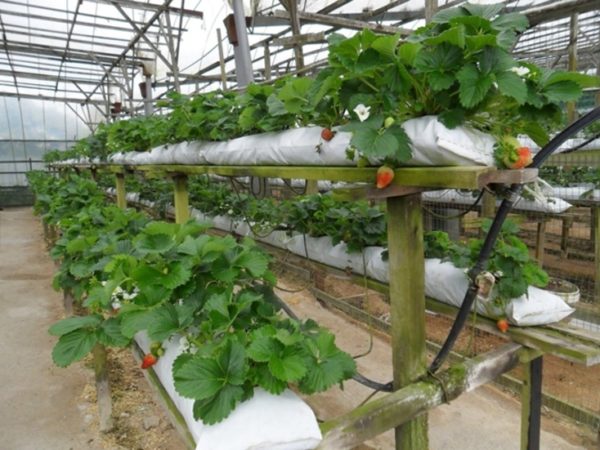

Growing according to Dutch technology
How to choose seedlings
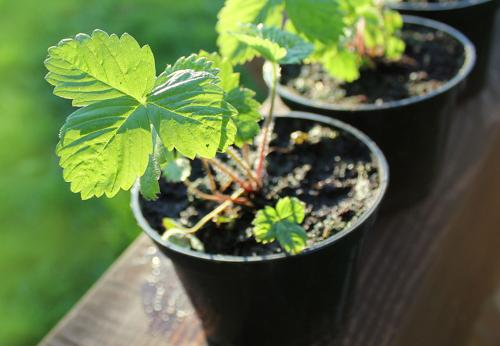

- The diameter of the root collar should be up to 6 cm.
- The length of the root processes should be more than 7 cm.
- The seedlings should already have 3 to 5 leaves.
- There must be an apical kidney.
- The roots should be white and between 3 and 5 cm long.
If you have chosen seedlings, you need to plant them as soon as possible, without tightening. Remember that if for unforeseen reasons you cannot sow, then dig it into a wet and loose soil, so it can stand for about two days. Provide such seedlings with coolness, and wrap the moss in its roots, it is better if it is wet.
Soil preparation
For landing, you should choose a well-lit place that will not be blown by the wind. In addition, the vertical bed requires special filling.
Drainage is poured into its base to a height of 10–15 cm. For this purpose, pebbles, crushed stone or gravel are suitable. Further, the container is filled with a mixture of various components in the following ratio:
- 20% manure;
- 30% matured compost;
- 25% turf;
- 25% peat.
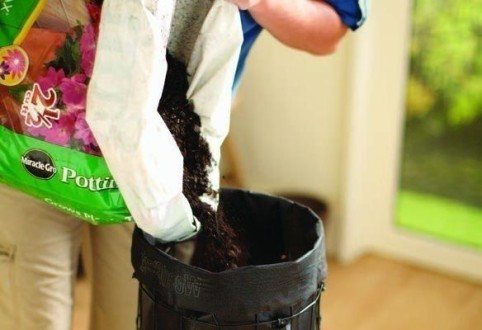

ADDITIONAL MATERIALS
Cherry care, cultivation and diseases
Today the world knows about 4,000 thousand species of sweet cherries. They were divided into two groups
How to grow strawberries in containers
Strawberries are one of the tastiest, sweetest and most desirable delicacies that you and me
Blueberry varieties
Shield blueberry Shield blueberry (or tall) blueberry is the most common blueberry cultivated in household plots. Berries
6 secrets of growing strawberries that no one will tell you about
Strawberry is a unique and at the same time versatile berry that can be combined almost with
Growing planting stock of strawberries
Industrial plantations are planted with healthy planting material and this is one of the decisive conditions for increasing yields.

